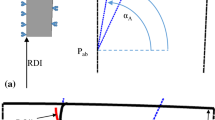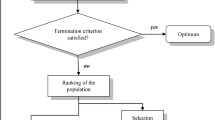Abstract
In this paper, an efficient evolutionary optimisation of a turbine blade firtree root local profile is presented. The firtree geometry is designed using an intelligent rule-based computer-aided design system (ICAD) and analysed using an industrial-strength finite element code. A large number of geometric and mechanical constraints drawn from past experience are incorporated in the design of the model. The high computational cost associated with finding optimal designs using high-fidelity codes is addressed using a surrogate-assisted genetic algorithm. The initial surrogate model is first built based on points sampled with a design-of-experiment method. A database of designs analysed using the high-fidelity code is built and augmented while the genetic algorithm progresses. In the procedure for deciding whether the high-fidelity code should be run, a simple 3σ principle is used instead of searching for the point with maximum expected improvement. This is combined with an appropriate ranking of the design points within the database. Some benchmark test problems are first used to illustrate the effectiveness and efficiency of the framework. When applied to the problem of local shape optimisation of a turbine blade firtree root, significant improvement is achieved using a limited computational budget.
Similar content being viewed by others
References
Ahn01 Ahn JA, Kim H, Lee D, Rho O (2001) Response surface method for airfoil design in transonic flow. J Aircr 38(2)
Alex98 Alexandrov NM (1998) On managing the use of surrogates in general nonlinear optimization and MDO. AIAA-98-4798
Alex97 Alexandrov NM, Dennis JE Jr, Lewis RM (1997) A trust region framework for managing the use of approximation models in approximation. NASA/CR-201745
Alex03 Alexandrov NM, Lewis RM (2003) First-order frameworks for managing models in engineering optimisation. 1st international workshop on surrogate modelling and space mapping for engineering optimisation, 11/16-19/2000, TDU
Bishop95 Bishop C (1995) Neural networks for pattern recognition. Oxford University Press
Booker00 Booker AJ, Dennis JE, Frank PD, Serafini DB, Torczon V, Trosset MW (1999) A rigorous framework for optimization of expensive functions by surrogates. Struct Optim 17(1):1–13
Canfield90 Canfield RA (1990) High-quallity approximation of eigenvalues in structural optimisation. AIAA J 28(6):1116–1122
Deberkow98 Daberkow DD, Marris DN (1998) New approaches to conceptual and preliminary aircraft design: a comparative assessment of a neural network formulation and a response surface methodology, AIAA. World Aviation Conference, September 28–30, 1998, Anaheim, CA
ElKeane99 El-Beltagy MA, Keane AJ (1999) Evolutionary optimisation for computationally expensive problems using gaussian processes. Proceedings of the Genetic and Evolutionary Computation Conference (GECCO99), Morgan Kaufman, pp 196–203
Guinta00 Guinta AA, Eldred MS (2000) Implementation of a trust region model management strategy in the dakota optimisation toolkit. AIAA-2000-4935
Guinta03 Guinta AA, Watson LT (1998) A comparison of approximation modelling techniques: polynomial versus interpolating models. AIAA-98-4758
HanVan90 Hansen SR, Vanderplaats GN (1990) An approximation method for configuratioin optimisation of trusses. AIAA J 28(1):161–172
Jin00a Jin R, Chen W, Simpson TW (2000) Comparative studies of metamodelling techniques under multiple modelling criteria. AIAA-2000-4801
Jin00b Jin Y, Olhofer M, Sendhoff B (2000) A framework for evolutionary optimisation with approximate fitness functions. IEEE Transactions on Evolutionary Computation
Jone98 Jones DR, Schinlau M, Welch WJ (1998) Efficient global optimisation of expensive black-box functions. J Glob Optim 13:455–492
Liang00 Liang KH, Yao X, Newton C (2000) Evolutionary search of approximated n-dimensional landscapes. Int J Knowl Based Intell Eng Systems 4(3):172–183
Matthew2003 Matthew W (1999) GAlib: a c++ library of genetic algorithm components. http://www.lancet.mit.edu/ga/
Morris Morris MD, Mitchell, TJ, Ylvisaker D (1993) Baysian design and analysis of computer experiments: use of derivatives in surface prediction. Technometrics 35:243–255
NairKeane98 Nair PB, Keane AJ (1998) Combining approximation concepts with genetic algorithm-based structure optimisation procedure
Ratle98 Ratle A (1998) Accelerating the convergence of evolutionary algorithms by fitness landscape approximation. Parallel problem solving from Nature V, 87–96
RobKeane99 Robinson GM, Keane AJ (1999) A case for multi-level optimisation in aeronautical design Aeronaut J 103:481–485
Sacks89 Sacks J, Welch WJ, Mitchell JJ, Wynn HP (1989) Design and analysis of computer experiments. Stat Sci 4(4):409–435
Schmit74 Schmit LA, Farshi B (1974) Some approximation concepts for structural synthesis. AIAA J 12(5):692–699
Sellar03 Sellar RS, Batill SM, Renaud JE (2003) Response surface based. Concurrent subspace optimisation for multidisciplinary system design
Simpson98 Simpson TW (1998) Comparison of response surface and kriging models in the multidisciplinary design of an aerospike nozzle. NASA/CR-1998-206935, ICASE report No. 98-16, 1998
Song02 Song W, Keane AJ, Rees J, Bhaskar A, Bagnall S (2002) Local shape optimisation of a firtree root using NURBS. 9th AIAA/ISSMO Symposium on Multidisciplinary Analysis and Optimization, Atlanta, Georgia 4–6 Sep 2002
Van99 Vanderplaats GN (1999) Structural design optimisation status and direction. J Aircr 36(1)
VanSal89 Vanderplaats GN, Salajegheh E (1989) A new approximation method for stress constraints in structural synthesis. AIAA J 27(3):352–358
Ven98 Venter G, Haftka RT, Starners JH Jr (1998) Construction of response surface approximations for design optimisation. AIAA J 36(12)
Wujek98 Wujek BA, Renaud JE (1998) New adaptive move-limit management strategy for approximate optimization, part 1. AIAA J 36(10):1911–1921
Author information
Authors and Affiliations
Corresponding author
Rights and permissions
About this article
Cite this article
Song, W., Keane, A. An efficient evolutionary optimisation framework applied to turbine blade firtree root local profiles. Struct Multidisc Optim 29, 382–390 (2005). https://doi.org/10.1007/s00158-004-0486-9
Received:
Revised:
Published:
Issue Date:
DOI: https://doi.org/10.1007/s00158-004-0486-9




